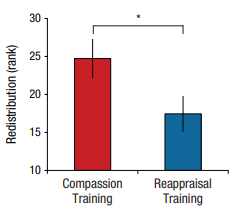Background Information
Compassion, one of the four
Brahmavihārās
Brahma Vihara meditation, also known as the Four Immeasurables, involves cultivating four qualities: loving-kindness (metta), compassion (karuna), empathetic joy (mudita), and equanimity (upekkha). It aims to develop a state of unconditional love, compassion towards suffering, joy in the happiness of others, and a balanced mind in all situations.
More on Wikipedia
View in glossary
or “divine abodes” in Buddhist practice, has long been regarded as a vital quality for both personal well-being and social harmony. Traditionally, it is cultivated alongside loving-kindness, empathetic joy, and equanimity, forming a cornerstone of contemplative life. Yet beyond its spiritual significance, compassion (generally described as the emotional response of caring for and wishing to alleviate others’ suffering) also plays a big role in fostering cooperation and altruism within societies.
While contemplative traditions have long claimed that compassion can be enhanced through meditation, modern scientific evidence examining the direct impact of such training on behavior and brain function remains sparse. This study explored whether compassion training could systematically increase altruistic behavior and, crucially, whether this behavioral shift would be reflected in changes in brain activity related to emotion regulation and social cognition.
What They Did
The authors recruited healthy adult participants with no prior meditation experience and randomly assigned them to two different two-week training programs. One group received compassion meditation training, where participants practiced generating compassion toward themselves and others, including loved ones, strangers, and even people they found difficult. The second group underwent reappraisal training, learning cognitive strategies to reinterpret stressful personal events in order to reduce negative emotions—serving as an active control.
Both groups completed daily 30-minute guided audio practices for two weeks and underwent brain scans before and after the training.
After completing the training, participants played an economic decision-making task designed to measure altruistic behavior. In this task, participants could choose to spend their own money to compensate a stranger who had been unfairly treated in a financial game.

Throughout the study, brain activity was measured via
fMRI
An fMRI (functional Magnetic Resonance Imaging) measures changes in blood flow related to neural activity in the brain, offering insights into brain function and activity patterns.
More on Wikipedia
View in glossary
while participants viewed images of human suffering. The researchers then examined whether changes in brain responses predicted shifts in altruistic behavior.
One Big Result
The key finding was that participants in the compassion training group exhibited significantly greater altruistic behavior than those in the reappraisal group. Specifically, they were more likely to sacrifice their own money to help a victim of unfair treatment, even though they were not instructed to apply their training during the task.

Compassion trainees spent 1.84 times more money than reappraisal trainees ($1.14 vs. $0.62, respectively) and increased the distribution between the dictator and the victim by 57%.
This increase in altruistic behavior was linked to changes in specific brain regions involved in empathy, emotional regulation, and reward processing. Notably, greater activity in the inferior parietal cortex and dorsolateral prefrontal cortex (DLPFC) was associated with increased generosity in the compassion group. In addition, stronger connections between the DLPFC and the nucleus accumbens (a brain region associated with reward) were also tied to greater altruism.
These neural shifts suggest that compassion training enhances both the capacity to recognize others’ suffering and the willingness to take action to alleviate it.
Miscellaneous Interesting Takeaways
Compassion Changes Neural Circuits for Good
The compassion group showed increased activation in brain areas related to both emotional control and perspective-taking, suggesting that compassion practice may strengthen the ability to remain engaged with others’ suffering without becoming overwhelmed.
Emotional Calmness Supports Altruism
Participants in the compassion group who reported feeling calmer while viewing images of suffering were more likely to act altruistically. This calming effect was associated with greater engagement of brain circuits involved in positive emotional processing.
Active Control Training Had Opposite Effects
Interestingly, in the reappraisal group, increased activity in similar brain areas was associated with less altruistic behavior. This highlights how the intention behind emotional training—whether focused on self-regulation or compassion for others—can fundamentally shape its outcomes.

Compassion trainees who showed greater DLPFC-NAcc connectivity redistributed more funds after training, whereas reappraisal trainees who showed greater DLPFC-NAcc connectivity redistributed less money after training.
Final Reflection
This study challenges the notion that compassion is merely a fixed trait, offering compelling evidence that compassion can be intentionally cultivated through meditation.
Our findings support the possibility that compassion and altruism can be viewed as trainable skills rather than as stable traits.”
Compassion is not just a feeling; it’s a trainable skill that reshapes the brain and promotes altruistic behavior.
Citation
Weng, H. Y., Fox, A. S., Shackman, A. J., Stodola, D. E., Caldwell, J. Z. K., Olson, M. C., Rogers, G. M., & Davidson, R. J. (2013). Compassion Training Alters Altruism and Neural Responses to Suffering. Psychological Science, 24(7), 1171–1180. 10.1177/0956797612469537